Sonic Frontiers: Sonic’s back, baby!!!
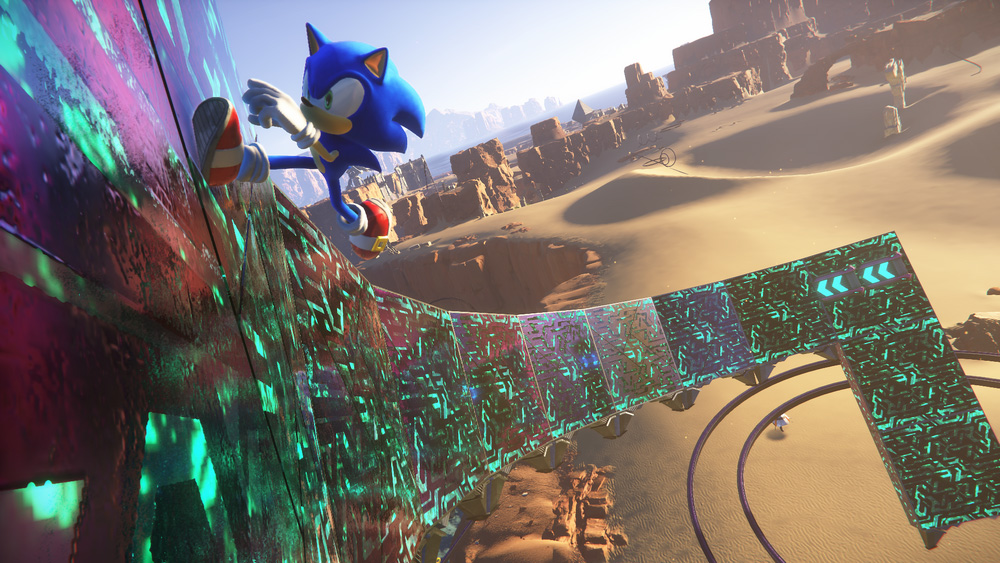
It‘s a miracle that Sonic Frontiers is as good as it is.
I don’t mean that I’m shocked a 3D Sonic game is fun. I like 3D Sonic games. As readers of my blog Thanks Ken Penders know, I’m a huge fan of the franchise, even if I’m not blind to its many flaws.
No, the miracle here is that this open world Sonic game could have so easily been the most cynical thing they’ve ever made. An attempt to strip Sonic of its identity in favor of making another bland, trend-chasing, design by committee AAA game after a decade with no clear direction. I get that the generic aesthetics of the open world seem to signal this. In June, my best case scenario was that the game would be boring, but that it might at least have some good dialogue thanks to longtime Sonic comic writer Ian Flynn, who I was ecstatic to see writing a mainline game.
Instead, Frontiers has more heart than any 3D Sonic game in years, embracing so much of what makes the series fun and amping it up to new levels. It’s absolutely not without its flaws, but as a lifelong fan of the series I’ve never been more excited about its future than I am now.
Sonic’s back. He’s really, really back.
(Note: I played Sonic Frontiers on PC. Experiences with other versions may differ. Also, this article will contain full spoilers. I’ll give a warning before discussing the big ones.)
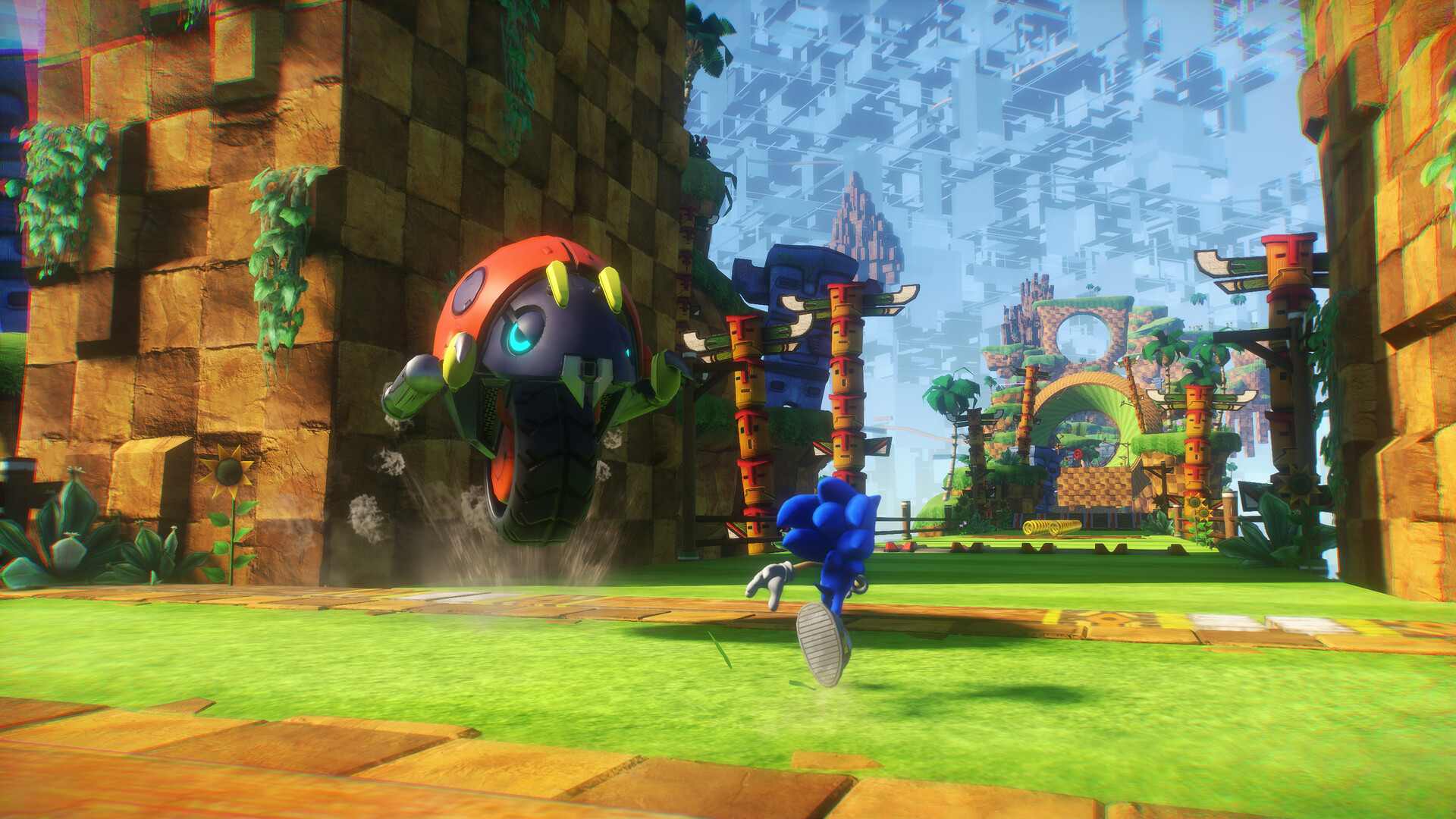
Sonic’s back, but give him a minute to warm up first
As with the marketing campaign, Sonic Frontiers doesn’t make the strongest first impressions. After a couple cutscenes, the game drops you into the first Cyber Space level (yet another version of Green Hill), where the only really new thing is Sonic’s tweaked control physics.
Jump and homing attack are separate buttons again. The boost’s speed is nerfed a bit, and it no longer damages enemies — no more “boost to win” here. But Sonic also feels like he stops on a dime more easily than you’d expect. In my 20 hours with the game, I never did quite figure out what determined whether or not Sonic would stop dead in his tracks if I let go of the stick while boosting. This stopping power makes more sense when something catches your eye in the open world, but while trying to maintain flow in a linear stage it can feel weird. Once I got used to the changes, though, controlling Sonic felt natural to me, and I never encountered any major bugs.
I’ve never been one to get so granular about the movement physics in 3D Sonic, so I can’t speak for people who think Frontiers feels bad to play. I think this is just one of many areas where what’s “right” for Sonic will be different for everyone. Apparently Sonic Team feels the same, because this time they let players decide how Sonic controls through a bunch of sliders in the options menu (and two presets up front). This was a great idea. Some have been enjoying the game more after cranking everything to the max, but I personally thought Sonic felt less slippery if I turned his starting speed down, making him briefly build up to a run sort of like in the Genesis games. This made the occasional bits of more precise platforming a breeze for me.
After finishing the level, you’re taken to the tutorial area of the first island, where you’re bombarded with blunt tutorial popups that seem like they were added in response to confused focus testers. With these initial hurdles out of the way, though, the real fun can begin.

The joys of the Open Zone
I think I deserve a medal for going this long before namedropping Breath of the Wild.
I know people are getting sick of every open world game getting compared to BotW, but like, come on. This is a game where the hero is dropped into a natural landscape dotted with the mysterious ruins of a long-dead kingdom as moody piano music plays in the background. You solve puzzles. You climb towers. You fight four colossal mechanical bosses. You collect funny little guys who are hiding all over the map and give them back to their elder to increase your carrying capacity. Come on.
That being said, while Frontiers is clearly aping the vibes of BotW, it isn’t mimicking the gameplay or structure. It can be hard to understand until you’ve played it. If you’ve seen one big ol’ map littered with icons, you’ve seem them all, right? But no. Frontiers is very much an action-platformer through and through, and it’s a delight to play because of it.
Each of the “five” (really four) islands Sonic explores is a big, open-ended playground of smaller platforming challenges to complete. Upon getting to the mainland of the first island, I quickly fell into a rhythm where I’d gleefully zip around the map from one small objective to another. People made fun of all the rails in the sky and how poorly they seem to be integrated into the world, which is fair, but they sure do catch your eye. You’ll spot a collectible at the end of a series of floating rails and set off to figure out how to get up there. You’ll uncover a hidden spring which launches you towards a set of platforms you couldn’t previously reach, and after getting through those a boost pad will point you in the direction of three more mini-challenges. I was in a constant loop of “ooh, what’s that over there?” because you’re never more than a few seconds away from more fun. And Sonic’s natural speed without the need for a car or a horse or whatever makes it a joy to traverse the map looking for these little challenges.
Even the obligatory Ubisoft tower climbs ended up being more fun than I expected because there were multiple ways to tackle them. For more observant players there are always some balloons to homing attack or rails to boost up just off the beaten path, and the new wall climbing sections can be done significantly faster if you boost into the wall instead of grabbing on normally.
I had my doubts, but this experiment worked. It’s pretty much free of the usual open world filler. You aren’t grinding for crafting materials, raiding copy and pasted enemy bases to slowly claim territory on the map, doing tailing missions, or being asked to defeat 20 of a specific enemy for an NPC. Even the generic Zelda puzzles you do to fill out the map (which I’ve made fun of previously) don’t feel like too much of a chore, being a short breather before you zip off towards more action. It’s just a Big Sonic Game where you do Cool Sonic Shit for 20 hours. As you read my nitpicks below, just know that none of it drowned out that core fun.

The Economy (of collectibles)
So yeah, it’s a good thing I found the core gameplay so innately pleasing, because the structure around it could use some work.
Sonic Frontiers incentivizes exploration via collectibles. The game thankfully knows you’re going to be running around at Sonic speeds and accommodates this, placing common items out in the open for you to grab without stopping and bluntly signposting other points of interest instead of making you methodically comb the map.
The thing is, the game doesn’t require (or even reward) completionism, as there are multiple ways to get just about every type of item, and many, many more than you’ll need of everything. On the one hand, this means you’re largely free to run around and do what you want, safe in knowing that you’ll have the items needed to progress before long if you just keep doing Sonic Shit. On the other… well, there’s nothing to do with the extra items that continue to litter the UI even after their purpose has been fulfilled.
The worst offender is the leveling system. Sonic gains “skill pieces” (EXP) from defeating enemies and doing midair tricks, which can be used to unlock moves on a skill tree. I’m fine with this, as it allows the game to slowly expand the combat rather than overwhelming you up front, and it lacks typical filler unlocks like +5% damage to one specific attack or whatever. The problem is that I maxed out the skill tree about halfway through the game, and after that kept racking up over 150 levels that couldn’t be spent on anything. Why do you even keep gaining EXP at that point? Who knows!
Sonic also has four attributes to level up. Ring capacity and max speed can be increased for every 20 Koco you find, but each upgrade is so negligible (+6 max rings per rank!) and it takes so long to redeem them one at a time with the Elder Koco that I quickly gave up. You also get a free speed boost at max rings, so raising the cap beyond 400 seems counterproductive. The Hermit Koco, meanwhile, redeems the items that bolster your attack and defense. Again, about halfway through the game my attack was at level 67 of 99 and I already felt overpowered, so I just stopped upgrading it and never looked back. I probably had more fun than the people who maxed out their stats and accidentally Saitama’d the penultimate boss.
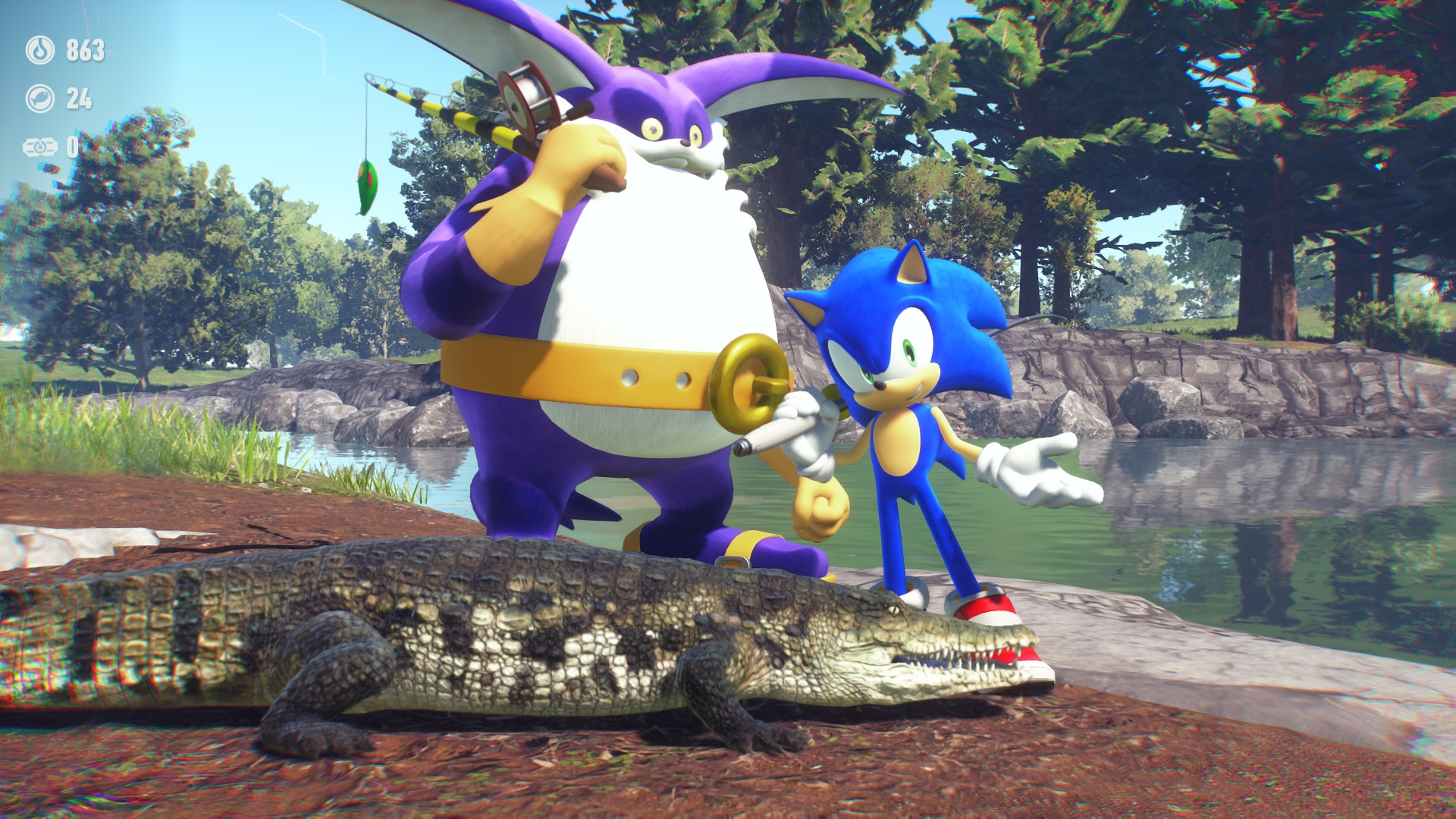
Then there’s also Big’s fishing minigame (side note: god bless), in which you can earn basically every type of collectible — as well as audio logs from Eggman, for some reason. It’s almost comical how easy it becomes to circumvent the loop of fighting minibosses to get Portal Gears, using Portal Gears to unlock Cyber Space levels, completing Cyber Space level challenges to earn Vault Keys, and using Vault Keys to claim Chaos Emeralds, all by just… fishing. Especially since you’ll have hundreds upon hundreds of the purple coins needed to go fishing after just a couple of those meteor shower events. The speedrun community is going to need a “no fishing” category.
But, again, I’m glad that the game let me play the way I wanted to play, rather than forcing me to grind for collectibles. I did all the Cyber Space levels not because I needed to, but because I thought they were fun. I just wish there was anything you could do with all those excess items. Even a simple shop where you could unlock more shoes or concept art or something would go a long way. (Or, you know… a Chao Garden, which served this purpose in the Adventure games.) Or maybe they’ll be useful when those newly announced free DLCs adding a bunch of new content drop.
Sights and sounds
While Frontiers manages to translate many aspects of the Sonic series into this new format wonderfully, the main letdown for me is the visuals.
Now, that’s not to say the game isn’t pretty. Because it absolutely is. The game is lit beautifully, and certain biomes and vistas within each island can be particularly impressive. There were a few points where I had to just stop and take a screenshot:
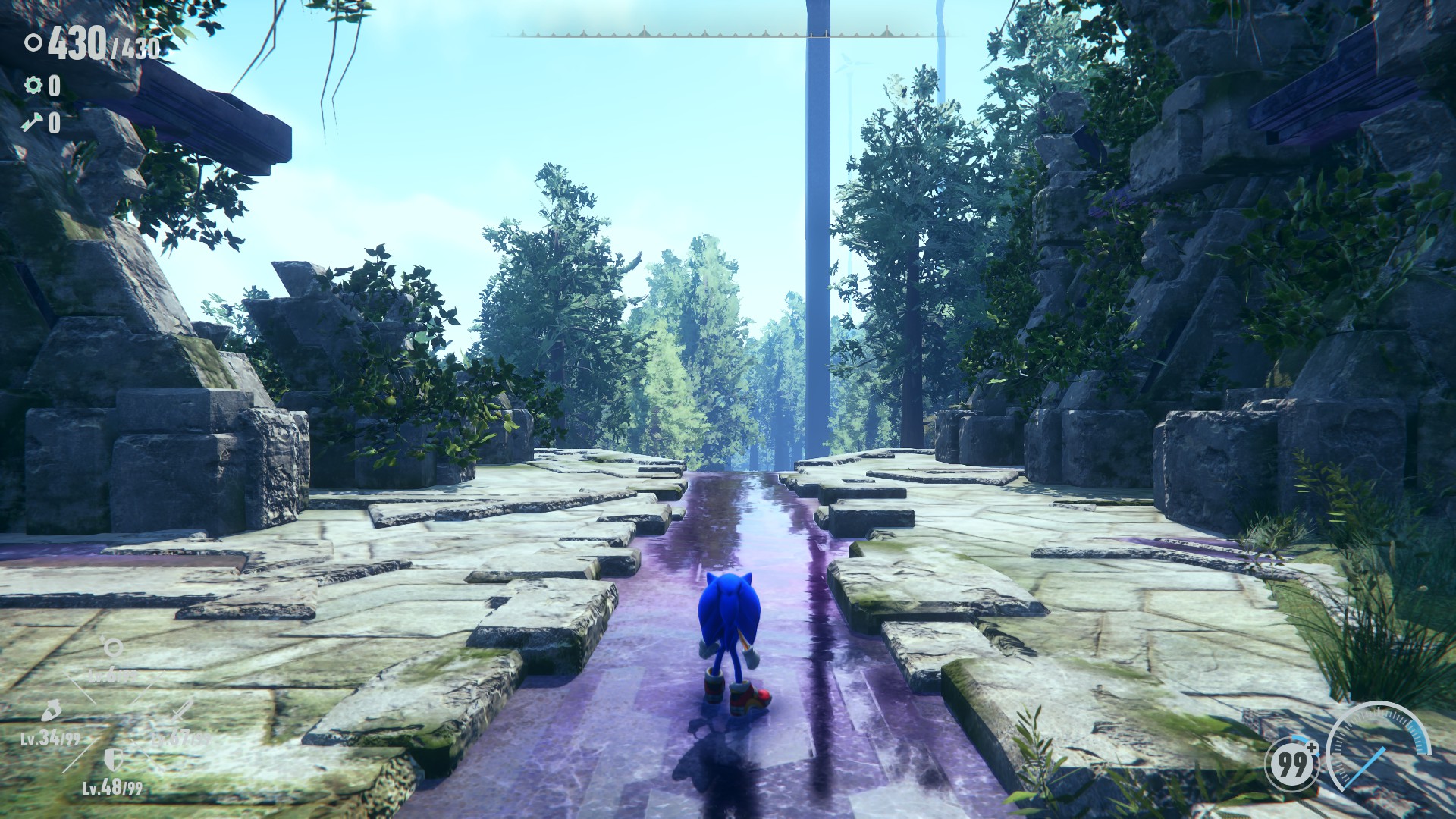
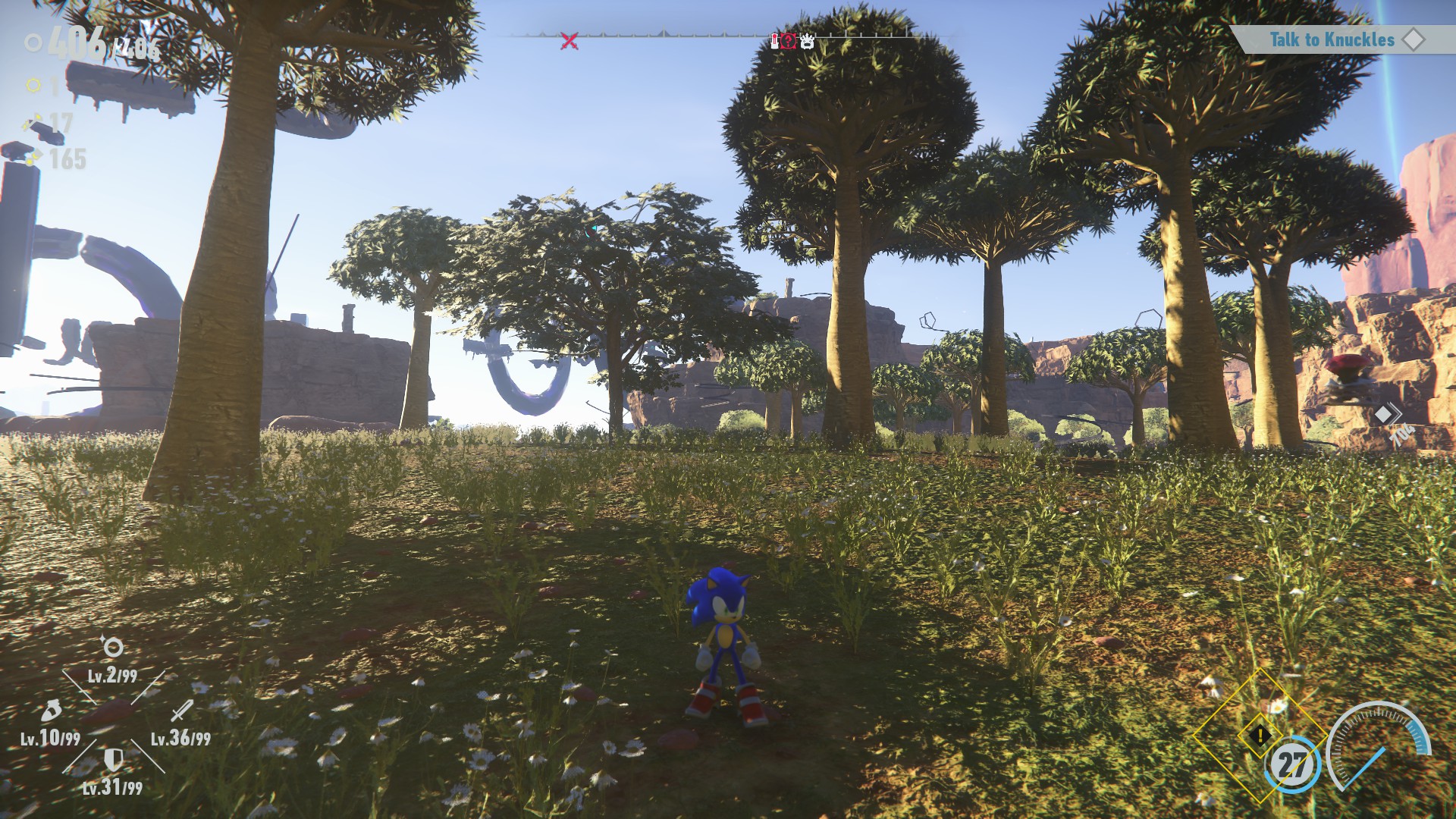
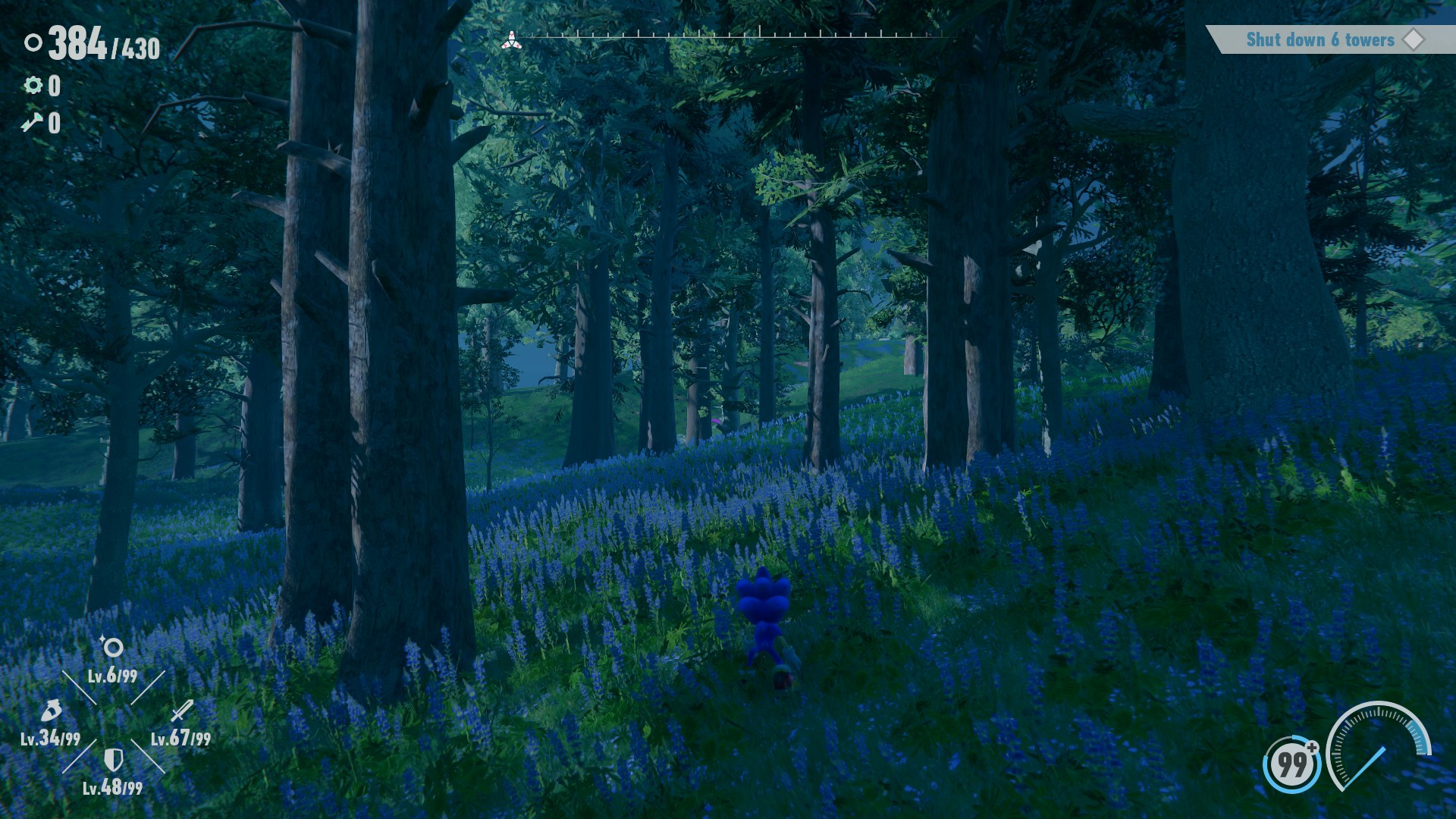
It’s just, you know… for the most part, it looks like dozens of other open world games. You’ve seen grassy plains and deserts and mountains like this before. You’ve seen these mysterious ruins. There’s nothing wrong with this look, but there’s nothing distinctly Sonic about any of it, either.
And sure, what “feels like Sonic” is another one of those things that fans will never universally agree on. I’m admittedly biased, because the hyper-stylized technicolor scenery of games like Kirby and 2D Sonic are some of my main artistic influences. I like when things are the wrong colors and when there’s shapes everywhere. They could’ve at least slapped some geometric patterns on that dirt or something. But it’s not even that the game shouldn’t have a “realistic” art style, because Sonic has pulled that off before! Previous entries would at least incorporate loops and corkscrews into the terrain. They’d also feature bustling cities, sprawling Eggman fortresses, and other environments that have been present in the series since the start. These open zones use just three nature biomes littered with abandoned ruins in the same art style for 20 hours, with only the Cyber Space levels to mix it up.
(For the record, I also completely, wholeheartedly reject the notion that the art direction needed to ditch the stylized environments and bright colors just because the story is more serious. That’s not how visual storytelling mediums work.)
But the real killer, if you ask me, is just how often it’s overcast or rainy. Worst off is the third island, Chaos Island, which is set atop a volcanic mountain range above the clouds. With a clear sky and a good view, this can be pretty striking! The way that white sea of clouds contrasts against the deep blue sky and the volcanic sands…
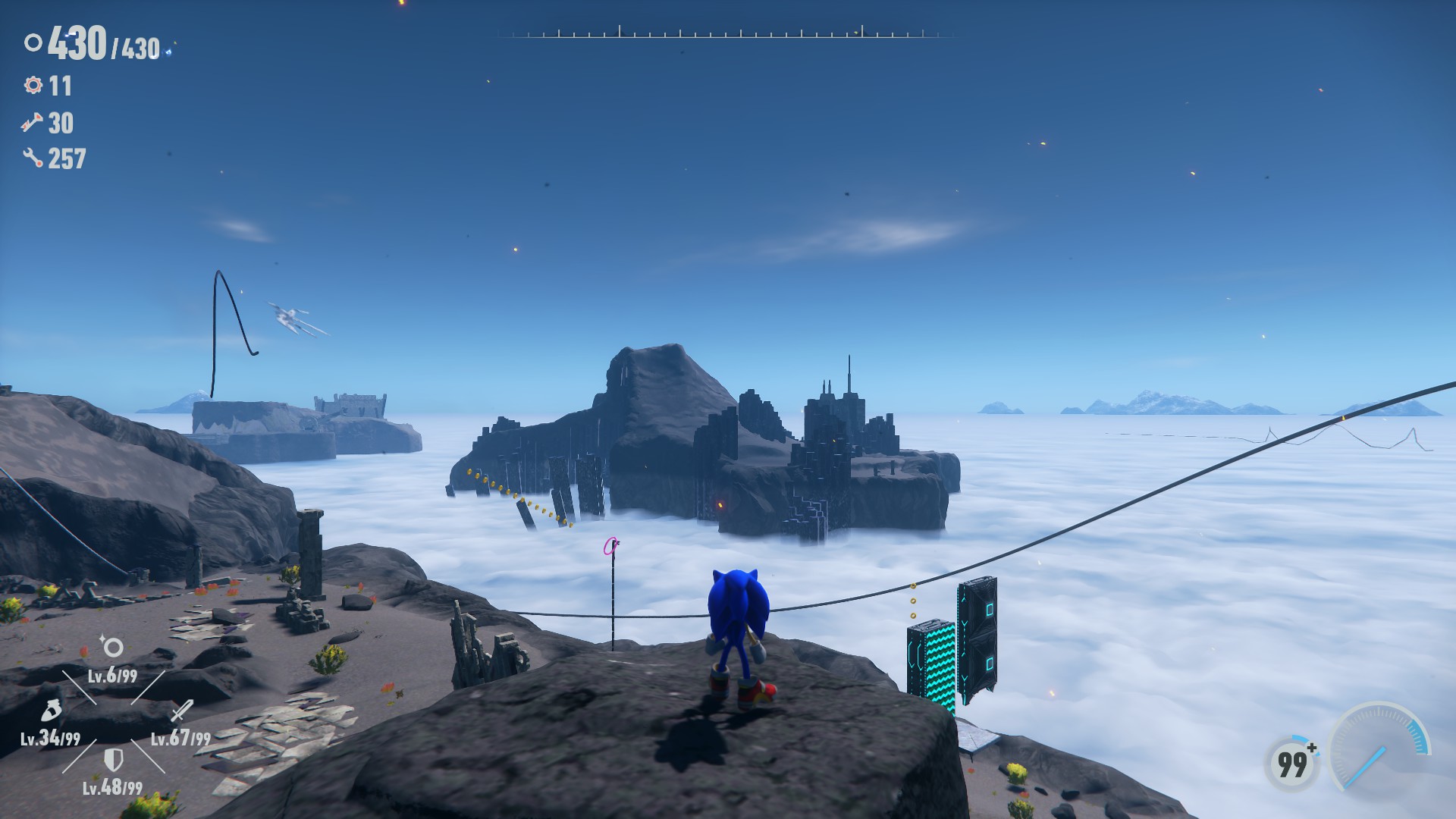
But most of the time it’s foggy, and with surprisingly little lava around it just becomes the fucking grey level.
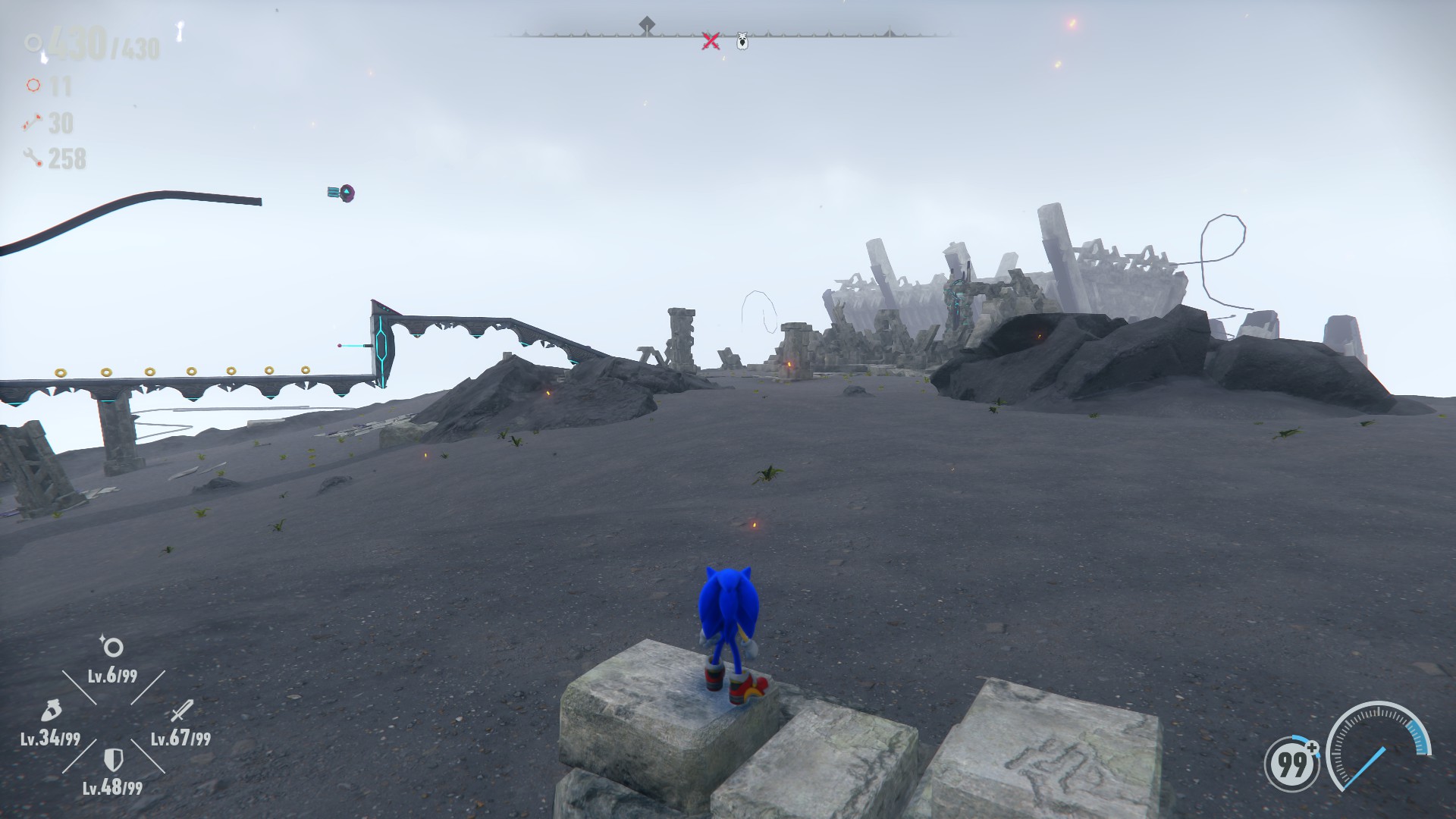
This and the frequency of forced 2D sections on this island made it the weakest of the bunch for me. This foggy greyscale look could be an interesting tone setter for a little while, but for four or five hours? Nah. It gets boring.
I could also say a lot of the same things about the music for the open zones. One of the main complaints about Breath of the Wild was its sparse use of music compared to past Zelda games, and I think that Frontiers proves pretty clearly why Nintendo did it that way. It’s because constant moody, subdued piano and strings gets fuckin’ old after a while. These parts of the soundtrack are competently made, and they fit the tone of the story and setting, sure. But they lack personality, and even the wise decision to update each area theme as you progress through the story only does so much to keep it from all blending together. BotW, on the other hand, uses its often minimalist music to highlight specific moments. It feels special when that lowkey piano rendition of the main Zelda theme starts up as you’re galloping across Hyrule at night. That still sticks with me almost six years later, as do decade-old memories of C418's music starting up at just the right moment in Minecraft. But I couldn’t for the life of me tell you what any variation of the Chaos Island theme sounds like after having literally booted the game up to take the above screenshots half an hour before writing this sentence.
There are certainly areas where the music shines, though. For instance…

Cyber Space
Everything about the Cyber Space levels in Frontiers screams “backup plan.” Ironically, they’re actually the weaker part of the game.
I can see the gears turning in the devs’ heads. They weren’t sure if people would like the open zones, so they threw in some regular levels and cautiously framed the open zones as simply big level select hubs. But they also couldn’t divert too much effort away from those massive open areas, so they decided to recycle level layouts from Unleashed, Generations, and Adventure 2 with glitched-out Generations visuals and frame it as a jumbled-up version of Sonic’s memories. This wouldn’t sting so bad if the preceding game hadn’t already reused half of these themes, or if Frontiers at least used more than the same four level themes throughout the game. You’ve seen every theme by the end of the first island. The glitch aesthetic can be cool, particularly the impossible freeways that stretch out in every direction in the city-themed levels, but why not take it further? Why not at least mash the assets from different levels together? Or recolor them? Anything!
Recycling aside, though, the Cyber Space stuff is mostly pretty decent. My main complaint with Forces, aside from the story being, in a word, bad, was that every level ended just as you were starting to have fun. The Cyber Space levels are still short here, but the framing as a side activity on top of the bountiful open world makes me enjoy them way more. The most obvious comparison here is the shrines in Breath of the Wild, but I would also compare them to the linear sub-areas you visit via pipe in Super Mario Odyssey. (In general, Odyssey’s kingdoms are a much better point of comparison for the structure of the Starfall Islands than any true open world.)
The gentle nudge towards trying to S-rank every Cyber Space level also makes them way more fun. Aside from the already infamous 1–2, the time attack limits are generally doable, and the levels are so short that they’re relatively painless to restart. I enjoyed figuring out which paths to take and how best to chain together my boosts, homing attacks, double jumps, air boosts, stomps, and more to maintain my flow. I didn’t do it for every level, but the fact that I went out of my way to get any of them here despite not usually caring about S-ranks says something.
Replaying the levels also gives you the chance to appreciate the music. While the visuals and stage layouts are recycled, Tomoya Ohtani and co. used the digital setting as an excuse to try out a wide variety of electronic music. Ohtani’s always loved his Amen breaks, so perhaps this was inevitable. Everything from EDM to drum & bass to techno to future bass to dubstep to trance is here (there’s a LOT of trance actually lol) and it’s all so, so good. Not only that, but every single level has its own bespoke track. They did NOT need to do that! Like, just. Listen to this. It speaks for itself. I love it. Where the orchestral open zone themes didn’t quite hit for me, the Cyber Space themes prove that any genre can be “Sonic music” so long as it has the right energy.
But, okay! Enough beating around the bush. I know what a lot of you really came here for. In Sonic circles I’m known primarily for writing about the American comics ad nauseam, and guess what? They finally got that one guy who writes for those to write a Sonic game. How’d he do?
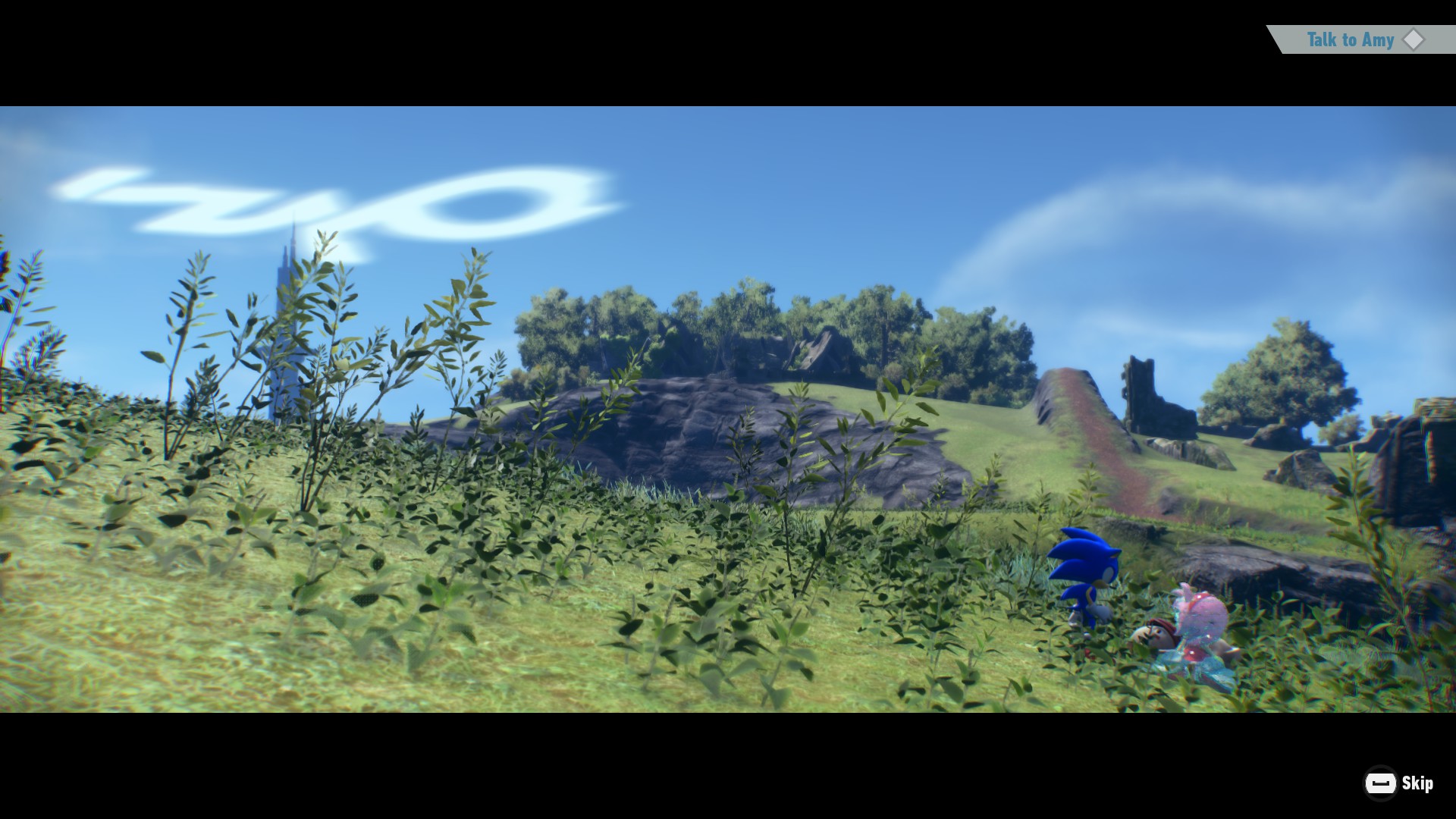
The story!!! (spoilers start here)
Prior to release, there were many debates about how much impact Ian Flynn would actually have on the story. His work as both lead writer on Archie Sonic throughout its final decade and the original writer of IDW’s successor series is widely beloved, but in the game industry how much input a script writer actually has varies wildly. I can now confidently say that, while Sonic Team may have provided the broad strokes for Ian, his creative voice is absolutely there, clear as day. And thanks to him this is the best Sonic story we’ve had in like 20 fucking years.
Depending on who you ask, that’s either a bold claim or damning Frontiers with faint praise. But to me this script’s a breath of fresh air. To be back to this mode of storytelling where the characters can sincerely engage with the story they’re in, where there can be mysteries with interesting payoffs, where there can be humor without constant terrible zingers and low-tier Canadian cartoon level jokes. I am so happy to be here. And to be here with an English script that sounds natural, with voice actors who are allowed to display some emotional range without odd timing issues. I know the bar is low, but this has been a struggle for years!
And the characters! Oh my god! The characterization feels spot on for the first time in years. When I saw Sonic and Knuckles’ first scene together, with Sonic being all smug about Knuckles needing to be rescued and Knuckles begrudgingly thanking him while also trying to puff himself up, I was ecstatic. Ian just gets these characters, and he’s eager to do them justice.
I was also pleasantly surprised by how much story there is in Frontiers. With talk of Sonic’s friends being trapped in Cyber Space and needing their memories restored, I was worried that Amy, Knuckles, and Tails would barely get to do anything. But while you do collect “Memory Tokens,” nobody has amnesia, and the first thing you do on an island is rescue the friend stuck there. After that they’re still stuck as holograms, but they’re able to freely roam the islands and participate in the story.
Personally, with Ian writing, I would’ve liked to see a few more characters show up outside of these “safe” ones. But the tight focus means that each island gets to showcase one ally’s story, and it’s kind of shocking what Ian got to do here: Sonic’s friends call back to past events in an attempt to reframe them as key points in cohesive character arcs.
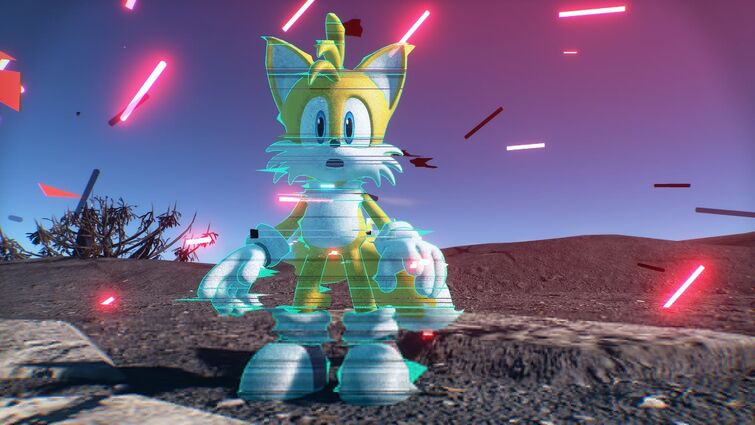
For example, in perhaps the most meta moment of the story, Tails discusses his past triumphs and failures and his nature as the sidekick with Sonic — the time he saved Station Square in Sonic Adventure, the time he saved Sonic from the Deadly Six in Lost World, and, of course, the time he completely shut down when confronted by Chaos 0 in Forces, a moment that’s never sat right with fans. “I’m wildly inconsistent,” Tails surmises at his lowest point here. This might be on-the nose, and it ALMOST crossed the line of being too much of a canonical Forces fix-it fic for me, but it’s saved by Sonic’s thesis for Tails as a character: that these highs and lows, these moments of bravery and moments where he’s overwhelmed and needs help from his friends, are all just part of growing up. And that even if he’s not perfect, Tails has come a long way in the time they’ve known each other, and Sonic’s proud of his little bro.
This. This is why people wanted Ian to write a Sonic game.
Interestingly, the use of continuity in Frontiers feels like how continuity tends to be treated in long-running comic books — and I don’t just mean because we’ve got a new writer coming in to fix shit the previous ones fucked up, like Ian did at Archie. I mean it’s written to theoretically be digestible for a newcomer (“every issue is someone’s first”), but it still references past events heavily. For returning fans, this adds extra layers to the story. For newcomers, hopefully they can use context clues to figure out the important stuff. And if they can’t, well… there’s a wiki? It’s a risky move for a game aiming for a broad audience like this, but if there’s one game series known for having an obsessive fanbase that already has all the old games memorized, it’s Sonic.
Beyond just touching on the past, Frontiers also treads new ground by looking to the future for each of these characters. Amy wants to see more of the world and share her belief in the power of love, even if it means being away from Sonic. Knuckles wants to get off of Angel Island more instead of accepting his lonely fate as the last echidna. And Tails wants to continue to grow more independent from Sonic. It feels like they’re setting up future stories here, if not in the games then at least in the IDW comics, and I’m super curious to see what comes of this.
Many will probably look at these stories and laugh, wondering why Sonic should have any drama at all. As someone who grew up with the Adventure games and the Archie comics, the reason is simple: the drama’s part of the charm. It can be taken too far (sorry zoomers, I am not about to defend the writing in Sonic ‘06), but I think the fact that there is something to latch onto on a dramatic level with the Sonic cast is one of the main things that separates the series from, say, Mario. The fact that they can have feelings and internal conflicts, that they can have stories where they learn and grow, where they can go through real hardships and come out the other side. That they can be more than sterile corporate mascot characters, even if that’s what they’re often treated as. Kids want to take the stories they love seriously, to get emotionally invested, and Sonic is a franchise that often rewards that desire instead of holding you at arm’s length. There’s a whole generation that still has a strong emotional attachment to Shadow because of his arc in Adventure 2, even if conventional wisdom might call the black and red Sonic lookalike with a complicated tragic backstory “tryhard” or “cringe.” It’s over-the-top, yes, but it’s earnest. And now that earnestness is finally back in full force.
Really, the only character in the group who feels a little weaker here is Amy, but I’d personally suspect that has more to do with Sega not knowing what to do with the character than Ian’s writing. Where Knuckles feels like a return to form after like 20 years of being such a nothing character in the mainline games, Amy’s depiction here seems to be an attempt to make sense of the character in this age where Sega wants her crush on Sonic to be downplayed.
There’s absolutely a lot of good here. This might be Cindy Robinson’s best performance as Amy, even if she’s never gonna sound like a 12-year-old. There are shades of Boom, but the Adventure influence is also strong, with Amy returning to her role as the kindhearted girl who always wants to look out for the little guys (the Flickies in Adventure, the Koco here) even when it’s not the most important thing to be prioritizing. But the fiery side of her personality is more tempered here than I’d like, especially with her being unable to smash robots with a mallet in hologram form. Toning down her one-sided obsession with Sonic is a move I like, but she can still get riled up or be quirky or even be a little abrasive. People love abrasive girls these days. Just look at Power. But, again, it’s hard to say how much of this is Sonic Team meddling, or how much her manic energy just couldn’t come out given the chiller tone they wanted for the whole story.
Sonic himself is great, though, with a solid performance as usual from Roger Craig Smith (even if the deeper tone of voice he slips into sometimes takes some getting used to). Like everyone else, he’s written much more earnestly, but he still has his moments of impatience and smartassery. If I have one small complaint here, it’s just that “amateur anthropologist” isn’t necessarily my favorite mode for Sonic to be in for 90% of a game. It’s wonderful to see him engaging with the story instead of just quipping, for sure, but many dialogue scenes are dedicated to deciphering the mysteries of the Ancients and wondering what different areas of the ruins were originally supposed to be. Which is, y’know. Probably a direct result of the homogeneous setting. I like that so much thought was put into the ruins as a place with a history and not just as a series of video game levels, but it’s another reason why I wouldn’t mind a little more variety for the next game, especially given how incredibly strong the character work is here.
On the subject of Sonic, though, he’s very much in line with his portrayal in the IDW comics, which is just a treat as a big fan of that series. His gradually worsening corruption from his journeys into Cyber Space contrasting with his determination to smile through the pain and save his friends evokes the Metal Virus saga. Given Iizuka has said they gave Ian the job after being impressed with the IDW comics, I have a feeling they outright asked him to channel that energy here. But where it really becomes clear that this is the same take on the character seen in the IDW comics is in his interactions with a new character: Sage.
Bigger spoilers will begin here.
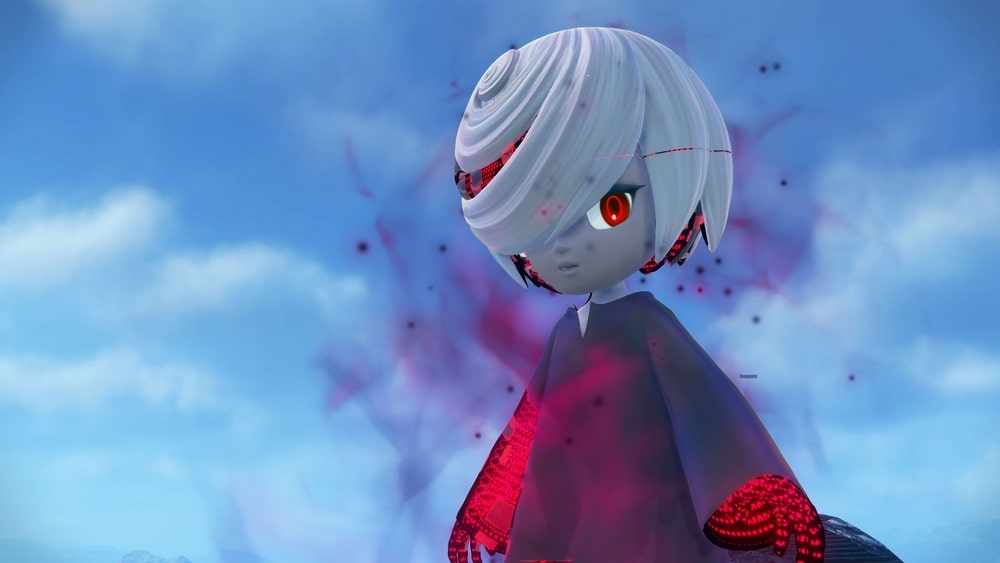
Sage
Great news for everyone who drew fanart of “Eggette”: Eggman has made himself an AI daughter, and she’s adorable.
I actually didn’t expect Sage to be that, since trailers always associated her with the ruins, not with Eggman. Really, she was just pitched as “mysterious, spooky little anime girl,” which didn’t grab me. But before long the game reveals that she is, in fact, the advanced AI Eggman designed to take over the Starfall Islands’ Cyber Space network. When Eggman is trapped in Cyber Space, it becomes her job to protect him.
Sage is cagey, at first a very cold character with machine-like logic, and her interactions with Sonic for the first few hours of the game mostly consist of her telling him to fuck off. She won’t elaborate because he’s Eggman’s arch nemesis, but she knows that Sonic is at risk of making a bad situation worse through his actions on the Starfall Islands. Sonic, on the other hand, refuses to see Sage as an enemy — he has no idea what her deal is and no real reason to fight her. Sure, he has to defeat a bunch of giant robots she points in his direction, but that’s business as usual for him. All he knows is that Sage is the only person who has any idea what’s actually going on, and therefore his only hope of saving his friends from being trapped in Cyber Space forever. It very much evokes the version of Sonic seen in the IDW comics who can and will kick ass, but who’s not eager to get into fights that could be avoided by simply talking things out. He’ll tell Sage to buzz off if she’s just being annoyingly cryptic again, sure, but all he really wants is info that can help safe his friends.
Over time, though, Sage sees how much Sonic loves his friends and the lengths he’ll go to to save them, even as she keeps telling him that it’s hopeless, and it awakens something in her: a desire to be loved like Sonic loves his friends — particularly the found family dynamic he has with Tails, which Ian highlights in the script.
Meanwhile, Eggman is extremely proud of his new AI. Part of this is that he’s really happy to see one of his creations be competent for a change. Part of it is that the eager-to-please Sage likes to deliver play-by-play mission reports of Sonic getting beaten up by robots, which Eggman eats right up. But like with Sage, there’s something more human being unearthed within Eggman here.
Eggman begins to view Sage as family.
He certainly fights it, trying to view Sage as just another machine, but it doesn’t take long for him to cave and refer to her as his daughter. He tries to write it off as pride over the fact that he’s created life (“And if I did create life, she would be brilliant and loyal and perfectly effective! And you know why? Because her dad is a genius, that’s why!”), but the most fascinating hint at what’s really going through his head comes from this memo:
“I never really knew my cousin, Maria. Everyone spoke of her like she was very special. All that love for someone who was gone when I was! Right! There! But I have to wonder. Back then, was she anything like Sage is now?”
It’s subtle, but you can read SO much into this. Again, it’s amazing that Ian was allowed to touch something like this at all with Eggman. Nobody in production told him to knock it off because people would call it cringe. They didn’t turn it into a joke. At worst we get an exchange where Sage goes “You… think he cares about me?” and Sonic goes “Sure! (In his… own way…)” and the line from Roger makes it genuinely hilarious.
Sage’s story arc may not be the most original thing in the world, and it can get cheesy, but by god, it has heart in a way that no Sonic game has had in years. It reminds me in some ways of Archie Sonic’s Nicole, Sally’s AI companion who slowly develops a desire to be “alive” and experience love, which has always been one of my favorite parts of that series. She also has some real shades of Rei Ayanami — and, wouldn’t you know it? The two share voice actresses in both English AND Japanese. Juxtaposing those vibes with her role as Eggman’s new sidekick makes her really, really fun, and I sincerely hope we see more of her.
Also just… look at how much I can write about Sage as a character. I could NOT do that with Infinite or Zavok. Sonic has ACTUAL WRITING again, y’all!

The Titans (and other enemies)
People often wonder why Sonic has to be so weird, based on assumptions of what a scrimblo bimblo platformer series is allowed to do. Why couldn’t he just be like that nice Italian boy Mario down the street? Sometimes these criticisms were absolutely fair and were echoed within the fandom itself. Other times it comes off more as people being unwilling to engage with Sonic in good faith, or simply a failure to understand what kind of story Sonic actually wants to be. Despite his design influences, Sonic has never 100% wanted to be a classic rubber hose cartoon. Sonic wants to be some flavor of shounen anime. He literally goes Super Saiyan in the second game. But after a decade of mixed reception in the ‘00s, Sega shied away from much of this, wanting to make Sonic more like Mario. This was most evident in Colors and Lost World. And I like both of those games! They were the games Sonic needed at that time. But it would have been such a shame if they stuck with that tone forever.
Thankfully, they didn’t. Because now the biggest Sonic game ever made also has boss fights where Super Sonic does shounen anime finisher moves on gigantic robot kaiju as metalcore music plays.
This was the moment when I knew for certain. Sonic is cool again.
Let’s back up a bit. The Titan boss fights build upon the new combat. Past Sonic games have tried to incorporate more combat into the series for the sake of variety (and padding) to mixed results. Giving enemies health bars often just meant mashing A to homing attack repeatedly. The Werehog gameplay was fine, but it distracted from the things you actually wanted to be doing (breaking the sound barrier in Rooftop Run). This time, they finally figured out how to put melee combat in Sonic. The answer is to not make it another mode of gameplay at all. Just give it to Sonic.
The effect here is that enemies and bosses are more fun to fight than they’ve ever been, turning into a light character action game complete with special attacks, dodges, and the world’s most generous parry. The earliest footage made fights look slow and laborious, but it’s just a matter of learning the strategies. I found it super satisfying to tear down enemies that had previously given me trouble in seconds after learning their weaknesses. Is it as deep as a Platinum game? No. But it doesn’t need to be, since most of the game is still a platformer.
In general the new enemies have a ton of variety in how they make you utilize Sonic’s moveset, with many even creating small platforming challenges. Some minibosses like the Squid will create roads in the sky that you have to chase them down. Some have shields that you can quickly use the Cyloop to destroy. One enemy traps Sonic inside itself, forcing you to stomp your way out. They’re honestly all great, but perhaps my favorite of the regulars is the massive “Fortress” miniboss that you have to chase through the sky via rails it emits in its wake, just for the sheer spectacle of it.
But without a doubt, the absolute pinnacle of the game is the climactic fights against the Titans.

That new combat of Sonic’s pays off in spades when he transforms into Super Sonic for these fights, as his powered up form cranks all of his regular moves up to 11. Finally, Super Sonic is actually fun to play as! All of the anime influences are fully indulged in here, with beam struggle quick time events and Super Sonic creating shadow clones and more. And the designs of the Titans themselves rule, including a first Titan that has major Eva vibes and cool details like cascading rows of teeth that open up one by one when it fires a beam out of its mouth. And all the cinematic moments that play up the scale of it all and the absurd power of Super Sonic, such as when he steals the third titan’s mile-long sword to deal the finishing blow. And the music, oh my GOD the music. This is peak Sonic. Period.
You know how much fun I had with these boss fights? I died like ten times on the first one, and I didn’t even care. I went in with low rings, and with no way to pick up more rings in that fight (that I could see, anyway) I was on a strict 100 second time limit as Super Sonic’s ring counter slowly drained. I struggled to figure out how to optimize my attacks to deal enough damage to the boss within the time limit. It’s not actually that hard, but I didn’t realize that you can just hold down the buttons to parry instead of trying to time it precisely until I was several tries deep. But even with all those restarts, I was still having a blast. It gave me more time to savor the spectacle, to see more of Super Sonic’s powered up finishers, and most importantly, to listen to that high-energy vocal theme.
And I think those vocal themes, which I’ve absolutely been listening to on loop, are a perfect encapsulation of how the series has found its confidence again with Frontiers. A decade ago they never would’ve humored the idea of effectively writing a metalcore EP for this game. They would’ve been worried about people making fun of it, of the game “taking itself too seriously,” of it “clashing” with the protagonist being a blue cartoon hedgehog. They’d be worried about the vocals being written off as “screamo” that general audiences might find abrasive. Now they don’t give a shit about any of that, because actually? It’s fucking cool. Screw the haters.
Cringe is dead. Sonic is forever.
The Ancients
So here’s where this game really started making my eyes bulge out of my skull. By the end of the first island, you’ve caught a brief glimpse of what the Ancients looked like.
They look like this.

That’s… that’s Chaos.
Oh shit.
The excellent animated prologue starring Knuckles hinted that Frontiers would have ties to the lore of Angel Island and perhaps even the Chaos Emeralds themselves, but I didn’t expect them to delve this deep into the foundational lore of the franchise. I had always assumed that these were questions designed to never be answered, but boy have I been proven wrong. We now know the origins of the Chaos Emeralds.
The Chaos Emeralds are from SPACE!!!
That’s right, Archie readers! The weird lore about the Emeralds coming from space in Mobius’s ancient past is canon now! Well, not quite. Where Archie depicted tons of Emeralds in seven different colors raining down upon seven different planets from an unknown origin in space, Frontiers depicts them as a power source from the home planet of the Ancients, which they fled after it was destroyed by the true antagonist of Frontiers. As they traveled through space, Earth’s Master Emerald resonated with their seven Chaos Emeralds and forced them to land.
I’ll avoid recapping the entire story of the Ancients here, but there’s actually a decent amount of room for interpretation, which I personally find really cool. Obviously, the thing that sticks out is that they all look like Chaos, and an Egg Memo confirms they’re related. But some obscure lore already said that Chaos was a mutated Chao. Did they retcon this? Well, maybe, but Eggman also says that “After countless years, [the Ancients’] DNA corroded to the point they were completely transformed into a new species. Some kind of radiation affected them for eons, making them unrecognizable — except to a genius like me.” So maybe it’s the other way around. Chaos isn’t a mutated Chao… Chao are mutated Ancients, affected by some kind of radiation on Earth. And maybe the original backstory is still true! Maybe Chaos was a normal Chao, and the Master Emerald simply made him devolve into an Ancient. One way or another, Chaos seems to be an alien now. He did always kinda look like one.
This is just my read on it, and I’m sure there are other theories. But it’s just so fun that there’s so much to chew on here—and that I actually care to theorize about the story at all after having finished the game. What a change of pace. It’s no wonder Sega has a dedicated Sonic Lore Team now.
The End
With the truth of the Ancients revealed, so too is the true villain: The End, the source of the mysterious voice that goaded Sonic into defeating the Ancients’ Titans in the first place. Over the course of the final island, Sonic teams up with Sage and Eggman to gather the Emeralds one last time and save Earth from the cosmic scourge that destroyed the Ancients’ home planet. While standoffish around Sonic, Sage has been hoping he would work with Eggman basically the whole game, as it’s Eggman’s only chance for survival here. She’s the logical one, after all, and she’s run the numbers based on all those past games where the two teamed up to stop a bigger threat. And so Eggman begrudgingly inducts Sonic into the Eggman Empire — on a temporary basis, of course.
(Side note: the final island disappointingly uses a very similar biome to the first. It also has the problem that many open world games have these days where it doesn’t feel like there’s a true “final level” to build up hype for the finale, instead leaving you to just kind of go kill the final boss and roll the credits when there’s nothing else to do.)
After a final Titan battle that’s fine, if not the most flashy of the four (again, I stopped leveling up hours ago, so it put up more of a fight), things will diverge based on whether or not you’re playing hard mode. It’s weird. The only meaningful difference, aside from changing the second song in the credits, is that the battle with The End is skipped over altogether if you aren’t playing on hard, leaving it to be defeated purely via cutscene for one of the biggest anticlimaxes in the history of the medium. After all those insane Super Sonic fights, that’s it? Really? But I suspect focus testers had trouble with that fight, which has you controlling the final Titan as Sage using the Ikaruga-inspired bullet hell gameplay seen previously in a few hacking minigames. (I got through on my first try, and I attribute this purely to me getting into Touhou last year.)
The End also has a very unique design for a Sonic villain, and by that I mean it’s the Black Moon from Evangelion. I’m noticing a pattern…
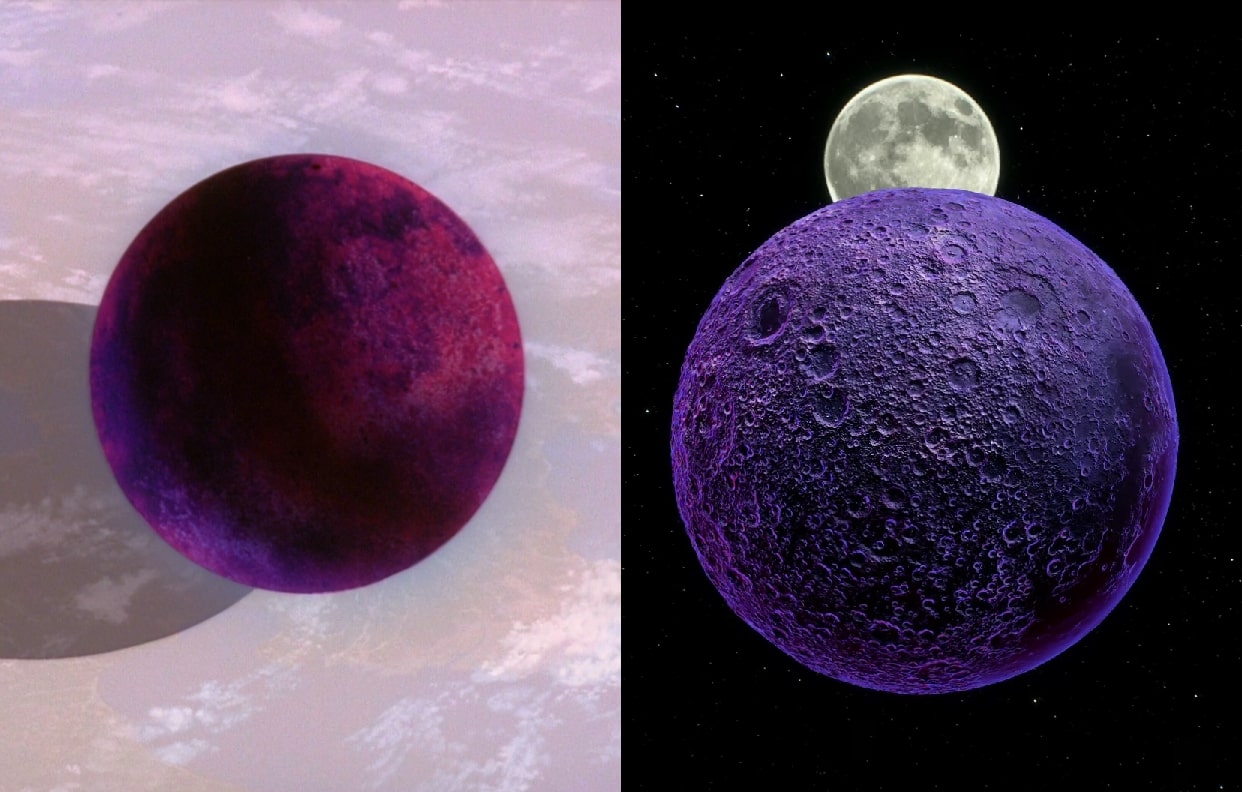
Folks seem divided on this. I like Eva, and Kirby has conditioned me to love unknowable cosmic horrors that take the form of evil space orbs (as well as genre-shifting final boss battles that turn into shmups), so I’d say I like it. But a second form of some kind with more of an actual Design that you fight as Super Sonic and one last vocal theme surely couldn’t have hurt.
The End comes dangerously close to being a JRPG final boss monster that shows up at the last second without ever being mentioned previously, but I think on a story level it works for me. For one, it was foreshadowed the whole game. But I also think the final boss monologue Ian wrote for it (which, again, you only get on hard mode) helps tie a nice bow on the themes of the story and the central tenets of Sonic as a character.
Sonic Frontiers is, in many ways, about moving on — a fitting theme for what the game represents for the series as a whole. Not running from the past and its sorrows, but accepting it, learning from it, and knowing that you still have to move forward anyway. Sonic and friends help the lingering spirits of the Ancients trapped within the Koco move on. Sonic’s friends, too, grapple with their own prior shortcomings and decide they need to move on with their lives, even if the past is filled with regrets and the future is uncertain. Sage wonders how Sonic can keep moving forward the way he does, fighting on as he grows more and more corrupted, even though she’s run the numbers and believes his fate is already sealed.
The End is the epitome of this. It’s the embodiment of entropy. It’s the void. The destroyer of countless other worlds. It’s the antithesis to the “teeming chaos of creation.” It’s the nothingness at the end of everything. How do you keep pushing forward when you know The End is coming? “What can one mote of golden light illuminate within the abyss?” But Sonic isn’t a mere mortal. He’s an ideal. He’s a force of nature. He’s the unwavering determination to keep going no matter what, to fight for your friends with everything you’ve got, because that’s love.
Is that cheesy as hell? Yes. It’s the time-honored message that the powers of love and friendship can never be defeated. And I wouldn’t have it any other way. Because that’s Sonic.
Sonic’s back, baby.
I’m here
Reaching far across these new frontiers
With my life I fight this fear
In my hands I hold the ones I love
Walk forward through the cold dawn
Always to new horizons
Epilogue: My wish list for next time
Iizuka has already outright stated that Sega views Frontiers as the basis for future games, like Sonic Adventure before it. In that regard, I think that Frontiers is a fantastic foundation to expand upon next time. So here’s what I’d like to see tweaked. Even a few of these would go a long way:
- Bring back Sage!!! She’s great. I want to see her be Eggman’s second in command more. I saw that damn post-credits scene, I know she survived her heroic sacrifice against The End. Please don’t let her be one of those characters that Sonic Team keeps in the toy box.
- Make the art direction of the open zones look less like an Unreal tech demo, and give the linear stages new themes. Ideally I would love it if they were set in “real” locations rather than being abstract challenges.
- Give the extra collectibles a purpose. Anything.
- Secrets! I was shocked to realize there are no interesting secrets on the Starfall Islands, just more collectibles. That’s one of the main points of even doing an open world to me.
- More NPCs — particularly, more of Sonic’s friends! My main wish was for them to include some fun side content with the supporting cast, and they didn’t do this. It would also be nice to have some kind of town or city for NPCs to inhabit instead of just ruins.
- Also, let the supporting cast interact with each other more in the story. It would’ve been nice to see Tails, Knuckles, and Amy play off of each other more.
- Tangle and Whisper get married — wait did I really go the whole article without mentioning that a comic-original character (Tangle) got a namedrop in a mainline game for the first time ever oh my god

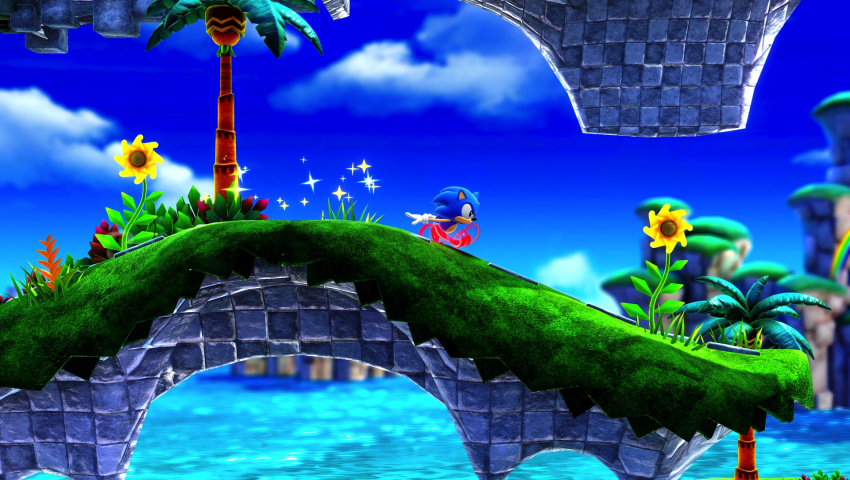
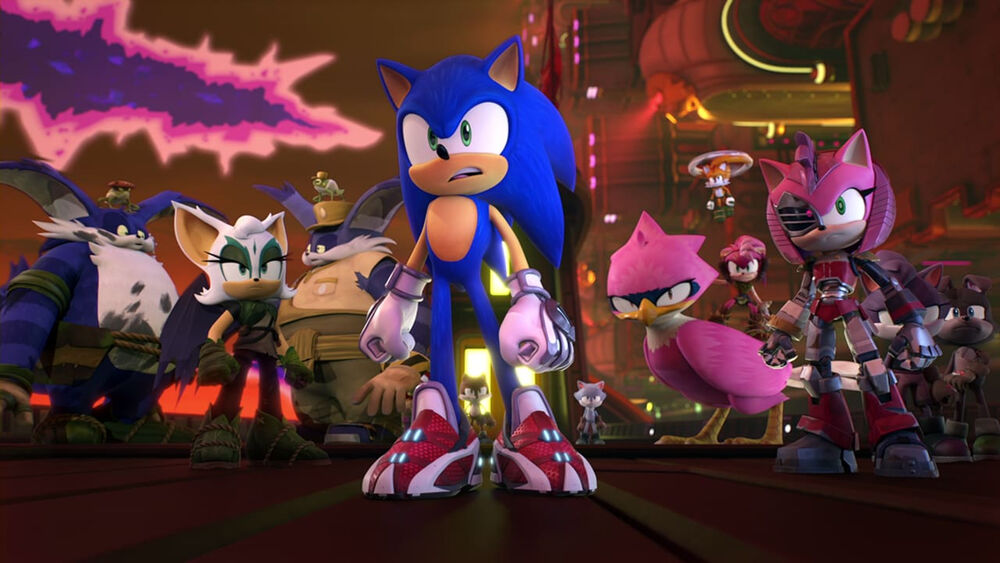
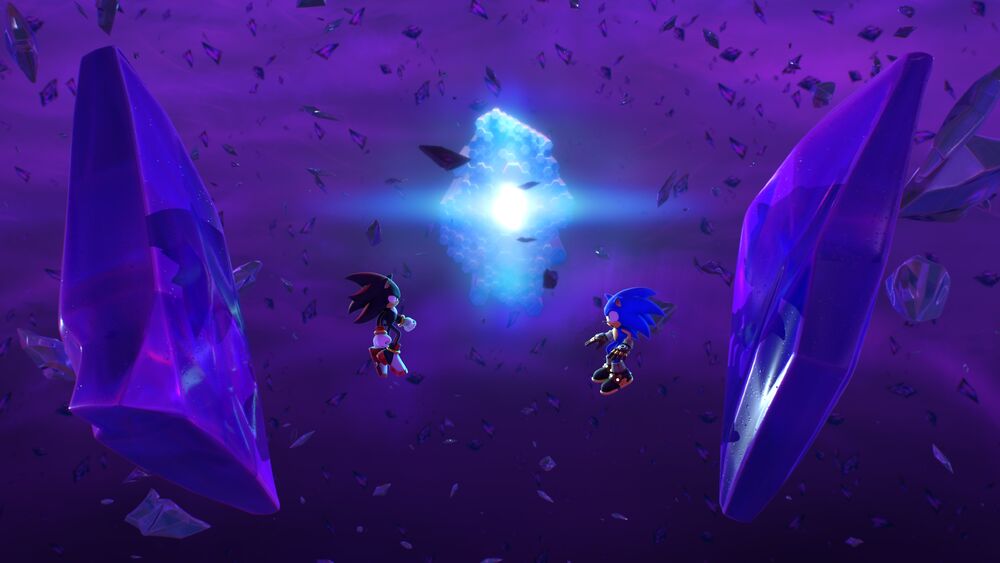
Comments